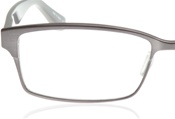All Categories
Glasses Frame Materials
- Plastics
- Metals
- Composites
- Different Types of Glasses
Cellulose acetate (zylonite)
- The most commonly used plastic in eyeglass frames, cellulose acetate is relatively inexpensive, easy to work with, and comes in a wide variety of colors, textures, and patterns. The material is easily adjusted but tends to get brittle with age
Cellulose proprionate
- This is a lightweight material that can be injection molded making it ideal for intricate designs. Care must be taken when heating and adjusting frames made of this material because it will shrink and ruin with overheating.
Nylon
- Many sports and safety glasses are made of nylon because it is virtually unbreakable and relatively lightweight. The material is, however, difficult to adjust and can be manufactured only in darker colors. It can also become brittle over time.
Optyl
- This material is somewhat lighter in weight than cellulose acetate and is hypoallergenic, an advantage to skin-sensitive patients. Frames made of optyl are more difficult to adjust because the material can return to its original molded shape, and the frames may break easily if not heated properly.
Polycarbonate
- Polycarbonate is 10 times more impact-resistant than conventional plastic or glass and is the material of choice for children's, sports, and safety glasses. Polycarbonate lenses are thinner and lighter than conventional plastic or glass lenses, and the material comes with built-in ultraviolet protection.
Kevlar
- Developed by DuPont for use in bulletproof vests, this plastic can withstand high impact such as that experienced in sporting events. The material is limited because it will not shrink or stretch, and it comes in few colors.
Aluminum
- Although very lightweight, aluminum is difficult to solder or weld, limiting its adaptability to different designs.
Cobalt
- Usually used as part of a metal alloy, cobalt appears in high-quality frames that can be made lightweight, durable, flexible, and thin. It can also be successfully coated with a variety of colors, but is very expensive and consequently limited in use.
Monel
- Monel is one of the most popular materials used in metal frames because it can be hammered into many shapes without losing its strength. It can also be made in various colors.
Nickel silver
- This is a common material used in hinges, end pieces, and heavy bridges, and for the inner core of temples. It is more brittle than several other metals, making it less suited to the slender frames so popular today.
Phosphor bronze
- This flexible alloy is about 95 percent copper, making it a good choice for temples.
Stainless steel
- Stainless steel is one of the most corrosion-resistant metals, but is difficult to work with in the manufacturing process.
Trilam
- This product is lightweight; however it has a memory, which can make frame adjustments difficult.
Carbon fiber graphite (CFG)
- CFG is a material made of nylon and carbon that provides the endurance of metal frames but is thin and lightweight. Although the material is black in its natural state, it is now available in a wide range of colors.
Copolyamide (MXP7)
- This material is a blend of nylon manufactured for frame-injection molding. The material is strong, lightweight, and durable, and it retains its shape unless heated.
Flexon7
- Flexon7 is a proprietary material made from a titanium-based alloy with a high "memory" factor that enables a twisted frame to return to its original shape. In addition to making frames extremely durable, the Flexon material holds adjustments longer and is lighter in weight than traditional metal frames.
Titanium Ti-227
- Titanium Ti-227 is nearly 50 percent lighter than most metal frame materials. It is hypoallergenic, noncorrosive, and one-third stronger than steel, making it an extremely desirable material for manufacturing frames. It's also difficult and expensive to extract and refine this abundant material.
Full Plastic Frames

- Full Plastic Frames is a frame made out of plastic that completely surrounds the lens
Full Metal Frames

- Full Metal Frames is a frame made out of metal that completely surrounds the lens
Semi Rimless Frames

- Semi Rimless Frames have a frame only on the top but not on the bottom or sides. The Lenses are attached to the frame by a thin nylon cord.
Full Rimless Frames

- Full Rimless Frames have no rim on any side. The lenses are mounted to the frame using screws. The screws are then cut down and a plastic tip is attached.